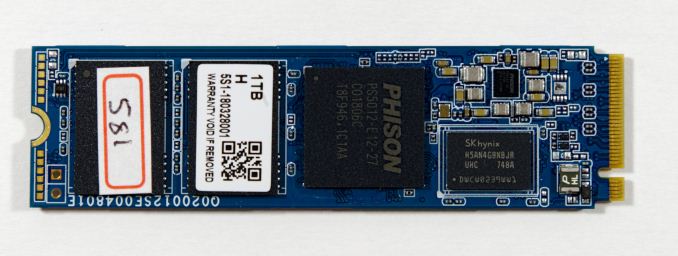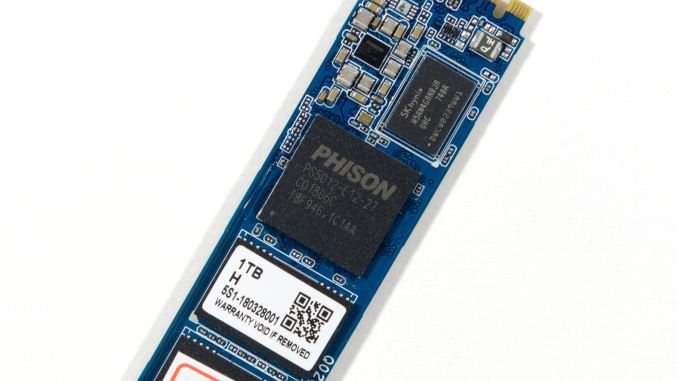The Phison E12 Reference Design Preview: A Next-Gen NVMe SSD Controller
by Billy Tallis on July 18, 2018 10:30 AM ESTLooking Forward
For months now, it has been clear that the best TLC-based SSDs are fast enough that even more expensive drives using MLC NAND or 3D XPoint memory are almost never justified. The Phison E12 controller does very little to further raise the bar for TLC SSDs, but it brings another player back in to competition at the high end. Within a few months, almost every SSD brand should be offering a respectably competitive high-end NVMe SSD. Most importantly for consumers, this will include brands such as MyDigitalSSD that are known for aggressively low pricing but have so far been limited to SATA and low-end NVMe drives when using Phison reference designs.
The Phison E12's best test results came from the write tests, where it set new records for burst sequential and random writes. Other drives with Toshiba/SanDisk 3D TLC tend to do well on write performance or power efficiency, so the Phison E12 isn't the top drive in all write-heavy tests. The E12's performance drops significantly when the SLC cache gets filled up and if the drive doesn't have enough time to finish flushing the cache before the next test phase, but even those performance drops only bring it down to about twice as fast as any SATA SSD. Phison probably could tune their SLC caching and garbage collection to offer better or more consistent sustained write performance on our synthetic tests, but it doesn't appear that such optimization is necessary for great real-world performance.
On the read side of things, the E12 offers good high-end performance but the HP EX920 with the Silicon Motion SM2262 controller and Micron 64L 3D TLC currently holds on to some impressive performance records. Silicon Motion should be able to expand that lead with their upcoming SM2262EN controller, so Phison either needs to figure out how to get better read performance out of Toshiba's 64L TLC, or hope that their 96L TLC will take care of the problem.
The Phison E12 consistently delivered very low read and write latencies on all of the ATSB tests, even when the Heavy and Light tests were run on a full drive. This applies not just to average latency but also 99th percentile latencies; the Phison E12's performance on these real-world storage workloads is consistently good.
The power efficiency of the Phison E12 is generally pretty good, even when the performance is not competitive with the top drives. The Phison E12 isn't quite as low-power as the year-old Toshiba XG5 that was the first shipping drive with this BiCS3 3D TLC NAND, but most of the tests where the E12 is more power-hungry are tests where the E12 is delivering enough extra performance to justify the power consumption. However, on almost all tests, the most efficient NVMe SSD is the impressive WD Black, which combines the same 3D TLC with Western Digital's in-house controller to deliver top performance with efficiency comparable to SATA SSDs.
Overall, the performance of the Phison E12 is competitive for today's SSD market given the price range I expect retail versions to show up in. Phison hasn't managed to leapfrog the competition in any big way, but they've caught up with the high-end for the first time since NVMe came to the consumer SSD market.
Phison may be able to continue incrementally improving performance through firmware updates, but it doesn't appear that the combination of the E12 controller and 64L TLC is at all future-proof when it comes to competing against the other drives that will be hitting the market during the second half of this year. Drives based on the Phison E12 will probably end up with more of a mid-range status within the NVMe SSD market, unable to deliver top performance but coming fairly close for a much smaller price. That should make E12 drives a pretty successful family of products with more mainstream appeal and affordability than Samsung's premium NVMe drives.
Looking back at how the Phison E7 fared as their first NVMe controller, the E12 is a huge improvement. The E7 was touted by many brands as a component for high-end SSDs, but it never really delivered. The most successful E7 products were the cheapest ones that didn't try to compete head-on with Samsung. The E7 controller also initially hit the market with relatively immature firmware, so many later products had substantially better (or at least different) performance from the first wave of releases. Phison has no obvious firmware flaws with the E12 platform, and it's probably ready to hit the stores.












28 Comments
View All Comments
Tastydirt - Sunday, August 5, 2018 - link
Not necessarily, depending on workload. A drive like this will read/write 4-8x faster than a SATA drive, allowing it to drop back into idle state much faster. This would probably result in lower total power consumption per byte read.DanNeely - Wednesday, July 18, 2018 - link
looks like a solid design to me, no bad results anywhere and optimizing for low latency over peak throughput in consumer scenarios is probably the better choice.takeshi7 - Wednesday, July 18, 2018 - link
I wish they kept the flip chip BGA design of the E7. It just looks cooler with the exposed die.imaheadcase - Wednesday, July 18, 2018 - link
Plan on admiring it inside case huh?FATCamaro - Wednesday, July 18, 2018 - link
He’s going to watch all those bits moving around the chip.Alistair - Wednesday, July 18, 2018 - link
A nice new possibility, but like the HP drive surprised me when I opened it, the Phison is double-sided unfortunately. I'd rather not buy Samsung, but Samsung being single-sided is a big plus.imaheadcase - Wednesday, July 18, 2018 - link
A big plus for what?DanNeely - Wednesday, July 18, 2018 - link
compatibility with laptops that don't have enough Z height for a 2 sided m.2 card.romrunning - Thursday, July 19, 2018 - link
It can also help with the cooling, if the controller is being impacted by higher thermals. The board-facing side may not have enough space to add even a small heatsink. Single-sided M.2 drives can benefit from placing the heatsink on the top side, along with whatever better airflow there may be the top side as well.siuol11 - Wednesday, July 18, 2018 - link
I really wish someone besides Samsung would make a "performance" drive with MLC, I'm not interested in using a TLC drive for a windows install. AFAIK there are no direct competitors to Samsung's Pro drives, and the prices have consequently continued to stay high.